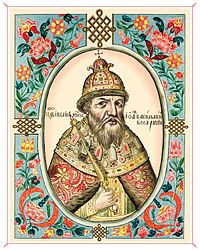Sovereign of all Russia
| Sovereign of all Russia | |
|---|---|
 Seal of the Sovereign (1475) | |
 Last to Reign Ivan IV | |
| Details | |
| Last monarch | Ivan IV |
| Formation | 12 February 1446 |
| Appointer | Hereditary |
The Sovereign of all Russia,[a][1][2][3] also the Sovereign and Grand Prince of all Russia,[b][c] was a title used by the grand princes of Moscow.[4] The title was later changed to sovereign, tsar and grand prince.
History
[edit]Dmitry Shemyaka used the title sovereign from 1446 and issued coinage with the title.[1] After his brother Vasily II returned to Moscow and took back the title of grand prince of Moscow, he also adopted the title of sovereign and began issuing coins with the title.[5]
Following the expansion of his realm and his marriage to Sophia Palaiologina, the grand prince Ivan III took the title of sovereign and claimed inheritance to all the former territories of Kievan Rus', including those under Lithuanian control.[6][7] His full title was: Ivan, by the Grace of God, the Sovereign of all Russia and the Grand Prince of Vladimir, and Moscow, and Novgorod, and Pskov, and Tver, and Yugorsk, and Perm, and Bulgar and others.[8] In diplomatic correspondence, the Latinized version of his title gospodar' vseia Rusi was dominus totius Russiae.[6]
The unification of the Russian principalities during his reign and the end of the "Mongol yoke" in Russia cultivated a sense of an imperial role for the Muscovite grand prince as the ruler of all Russia.[9] Ivan III also used the title of tsar in foreign correspondence,[10][11] especially as there was no longer a tsar in Constantinople.[9] Ivan had his grandson Dmitry crowned as grand prince using the crown of Monomakh for the first time, an item of Russian regalia that would be used to strengthen the claim of Moscow as the heir to the Byzantine Empire, though Dmitry would never reign.[9]
Notes
[edit]References
[edit]- ^ a b Hartog, Leo de (1996). Russia and the Mongol yoke: the history of the Russian principalities and the Golden Horde, 1221 - 1502. London: British Academic Press. p. 131. ISBN 9781850439615.
- ^ Filjushkin, Alexander (2008). Ivan the Terrible : a military history. London. p. 278. ISBN 9781848325043.
{{cite book}}: CS1 maint: location missing publisher (link) - ^ Payne, Robert (2002). Ivan the Terrible (1st Cooper Square Press ed.). New York: Cooper Square Press. pp. 24–25. ISBN 9780815412298.
- ^ Kidner, Frank L. (2014). Making Europe: the story of the West (2. complete ed.). Boston, MA: Wadsworth, Cengage Learning. p. 382. ISBN 978-1111841317.
- ^ Alef, Gustave (1986). The origins of Muscovite autocracy: the age of Ivan III. Wiesbaden: Harrassowitz. pp. 41–42. ISBN 9783447026062.
- ^ a b Sashalmi, Endre (2022). Russian notions of power and state in a European perspective, 1462-1725: assessing the significance of Peter's reign. Boston. ISBN 9781644694190.
{{cite book}}: CS1 maint: location missing publisher (link) - ^ Filyushkin, A. (2006). Титулы русских государей. Moscow: Альянс-Архео. pp. 170–174, 191. ISBN 9785988740117.
- ^ Filyushkin, A. (2006). Титулы русских государей. Moscow: Альянс-Архео. pp. 199–201. ISBN 9785988740117.
- ^ a b c Madariaga, Isabel de (2014). Politics and culture in eighteenth-century Russia: collected essays. Abingdon, Oxon: Routledge. pp. 15–25. ISBN 9781317881902.
- ^ Kort, Michael (2008). A brief history of Russia. New York: Facts On File. pp. 26–30. ISBN 9781438108292.
- ^ Crummey, Robert O. (2013). The formation of Muscovy, 1304-1613. London: Routledge. p. 96. ISBN 9781317872009.
